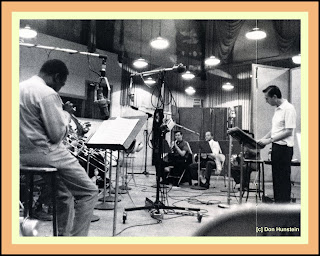Jazz Profiles Gil Evans: The Arranger as Re-composer (Part 2)
![]()
In his book, Arranging the Score: Portraits of the Great Arranger, Gene Lees entitles his chapter on arranger-composer Gil Evans – He Fell from a Star.
As far as I was concerned, Gil could have come from anywhere.
I had no idea who he was until he magically appeared in my life one day courtesy of Pacific Jazz’s LP: - New Bottle Old Wine: The Great Jazz Composers Interpreted by Gil Evans and His Orchestra.
The
album is a showcase for alto saxophonist Julian “Cannonball” Adderley
who offers superb renditions of Gil’s arrangements beginning with St. Louis Blues and concluding with Charlie Parker’s Bird Feathers.
In
essence, the eight treatments of Jazz classics on the album represent a
salute to the first 25-years or so of Jazz composition and Gil weaves
them together into a continuous “suite” through his use of transitional
interludes, riffs and vamps.
The Gil Evans and His Orchestra part
of the LP title is a bit of a misnomer because as Doug Ramsey explains,
Gil “… never had his own full time band. For three decades he did his
magical work with specially chosen musicians in studios and concert
halls or with his once-a-week band at New York
nightclubs. The evidence of his genius with shimmering vertical
harmonies, moving lines, and mysterious voicings is in a body of
recordings … .” [p. 415 from Doug’s essay Big Bands and Jazz Composing and Arranging After World War II, in Bill Kirchner, ed., The Oxford Companion to Jazz.
I
no sooner had the chance to “digest” my initial “discovery” of Gil when
suddenly he appeared to be everywhere present on the Jazz scene, mostly
in the form of a series of block-buster Columbia LP’s that featured the
trumpet playing of Miles Davis including Miles Ahead, Porgy and Bess and Sketches of Spain.

Who
was this guy, where did he comes from and why was he “… regarded by
many as the most gifted of all Jazz arrangers, but Ellington …?”
[Ramsey. Loc cit.].
From a variety of sources, I eventually found out that Gil’s relationship with Miles antedated their Columbia albums by a dozen or so years going back their initial meeting at the 52nd Street clubs that came into existence primarily following World War II.